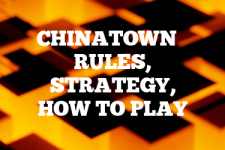A Guide to Taluva – Rules, Instructions & Winning Strategies
Introduction
Taluva, a tile-based board game with elements of strategy and building. It’s a game where you create a tropical island by placing hexagonal tiles, and then you build huts, temples, and towers on those tiles. The goal is to expand your settlements and block your opponents at the same time. It’s a pretty cool game that combines luck and skill.

Taluva was designed by Marcel-André Casasola Merkle and first published in 2006. Since then, it’s become a favorite for gamers like me who like games that are easy to learn but have a lot of depth. The game is for 2 to 4 players and usually takes about 45 minutes to play. It’s got a bit of a Carcassonne vibe (a game I’ve written on previously), but with a 3D twist because you can stack the tiles to create a multi-level island. It’s a game that’s easy to get into but can get really competitive when you start to see all the different strategies you can use.
Quick Tip for Taluva
Always keep an eye on your opponents’ settlements. If you see a chance to block their expansion, take it!
Rules for playing Taluva
Alright, let’s get into the rules of Taluva. The game comes with a bunch of hexagonal tiles that show different landscapes like volcanoes, jungles, and beaches. Each player has a set of wooden pieces representing huts, temples, and towers. The aim is to be the first to build all of two types of buildings or have the most temples when the tiles run out.
Here’s how the game works:
- On your turn, you draw and place a new tile next to the tiles already on the table. If there’s a volcano on the tile, it has to touch another volcano on the board.
- After placing a tile, you can build on it. You can either start a new settlement with a hut, expand an existing settlement, or build a temple or tower if your settlement is big enough.
- Settlements can’t touch each other, and you can’t build on top of other players’ buildings.
- You can also place a tile on top of other tiles to create a second or third level of the island. You can only build on the top level, and you need more huts to build on higher levels.
- The game ends when all the tiles are used up or when a player builds all of their huts and temples or towers.
There are some more detailed rules about how to expand settlements and when you can build temples and towers, but that’s the basic idea. It’s a game that’s easy to start playing, but you’ll find there’s a lot of strategy in how you place your tiles and where you build.
Equipment and Setup for Taluva
For Taluva, you need the game box, which comes with:
- 48 hexagonal tiles
- Wooden pieces for huts, temples, and towers for each player
To set up the game, shuffle the tiles and place them in several face-down stacks. Each player picks a color and takes all the buildings in that color. You’re now ready to start building your island paradise!
If you don’t have the game, you could try making a DIY version with cardboard tiles and small wooden pieces or even LEGO bricks for the buildings. Just make sure the tiles can stack on top of each other.
The types of tiles in Taluva are:
- Volcano tiles, which are the starting point for new layers of the island
- Jungle, beach, and other landscape tiles, where you can build your settlements
How to Play Taluva and Game Mechanics
Now let’s dive into how to play Taluva. The game has a few key mechanics:
Key Game Mechanics
You’ve got tile placement, building, and stacking. You place tiles to create the island, then build on those tiles to expand your settlements. You can also stack tiles to create new levels.
Setup
Each player starts with all their buildings. You randomly pick a first player, and you’re ready to go.
Gameplay
On your turn, you draw a tile and place it. Then you can either build a new hut, expand a settlement, or build a temple or tower if your settlement is big enough. You can also pass on building if you want.
End of the Game
The game ends when all the tiles are used up or when a player builds all of their huts and temples or towers. The player who does this first wins!
Here’s a list of gameplay phases:
- Tile Placement: Draw and place a new tile next to existing tiles.
- Building: Build a hut, expand a settlement, or build a temple or tower.
- Stacking: Place tiles on top of others to create new levels.
How to Win at Taluva
Winning at Taluva is all about strategy. You want to expand your settlements and block your opponents at the same time. Here are some tips:
- Start by spreading out your settlements so you have room to grow.
- Keep an eye on the tiles left and plan your moves accordingly.
- Block your opponents by placing tiles where they can’t build or by cutting off their settlements.
- Build on higher levels when you can, because it’s harder for opponents to block you there.
- Don’t forget about temples and towers. They can be a quick path to victory if your opponents aren’t paying attention.
As you play more, you’ll start to see deeper strategies and ways to set up your moves several turns in advance.
Best Strategies for playing Taluva game
Now let’s talk about some of the best strategies for playing Taluva. Here’s what you should aim for:
- Control the center of the board. It gives you more options for expansion.
- Try to keep your settlements separate so they can’t all be blocked at once.
- Use the third level to your advantage. It’s a powerful spot that’s hard to block.
- Watch for opportunities to trap your opponent’s settlements with clever tile placement.
And here are some sneaky tactics:
- Place a volcano tile next to an opponent’s settlement to limit their expansion options.
- Build a tower to claim a large area of the island for yourself.
- Expand your settlements in multiple directions to keep your opponents guessing.
Scenarios
Sometimes you’ll find yourself in a tough spot in Taluva. Here’s how to turn things around:
- If you’re blocked, look for a way to start a new settlement on a different part of the board.
- If you’re running out of room, try to stack tiles to create a new level for building.
- If an opponent is getting ahead, focus on blocking their moves while you catch up.
And if you’re in a good position:
- Keep expanding and don’t let up the pressure on your opponents.
- Plan your moves so you can build temples and towers before the game ends.
- Stay flexible and be ready to change your strategy if the board changes.
Frequently Asked Questions about playing Taluva game
Here are some common questions and answers:
- Q: Can I move my buildings once they’re placed?
A: No, once you place a building, it stays there for the rest of the game. - Q: What happens if I can’t place a tile?
A: You always have to be able to place a tile. If you can’t, you’re out of the game. - Q: Can I build on a volcano?
A: No, you can’t build on volcanoes. They’re just for placing new tiles. - Q: How many buildings can I place on a turn?
A: You can place one building or expand a settlement by placing multiple huts. - Q: What if two players finish their buildings on the same turn?
A: The game ends immediately, and the player whose turn it is wins.
Additional Subtopics
Here are some other things to keep in mind when playing Taluva:
Tile Counting
Keep track of which tiles have been played. Knowing what’s left can help you plan your strategy.
Player Interaction
Taluva is not just about building; it’s also about interacting with other players. Pay attention to their strategies and adapt your play accordingly.
Endgame Scenarios
As the game nears its end, focus on completing your temples and towers. They can be the difference between winning and losing.
External Links
For more information on Taluva, check out these links:
Taluva Review [Video]

A digital native around since the early days of online gaming communities around 2001. An early contributor to the cult gaming site ClanTemplates, Adam has spent years giving free gaming resources to the community. With BoardCards, Adam is most experienced and commonly writing the articles on Strategy multi-player games like Settlers of Catan and Avalon. His first introduction to board games was via Mancala, an Egyptian-origin stone game and one of the oldest known games still played worldwide. Contact me via email



